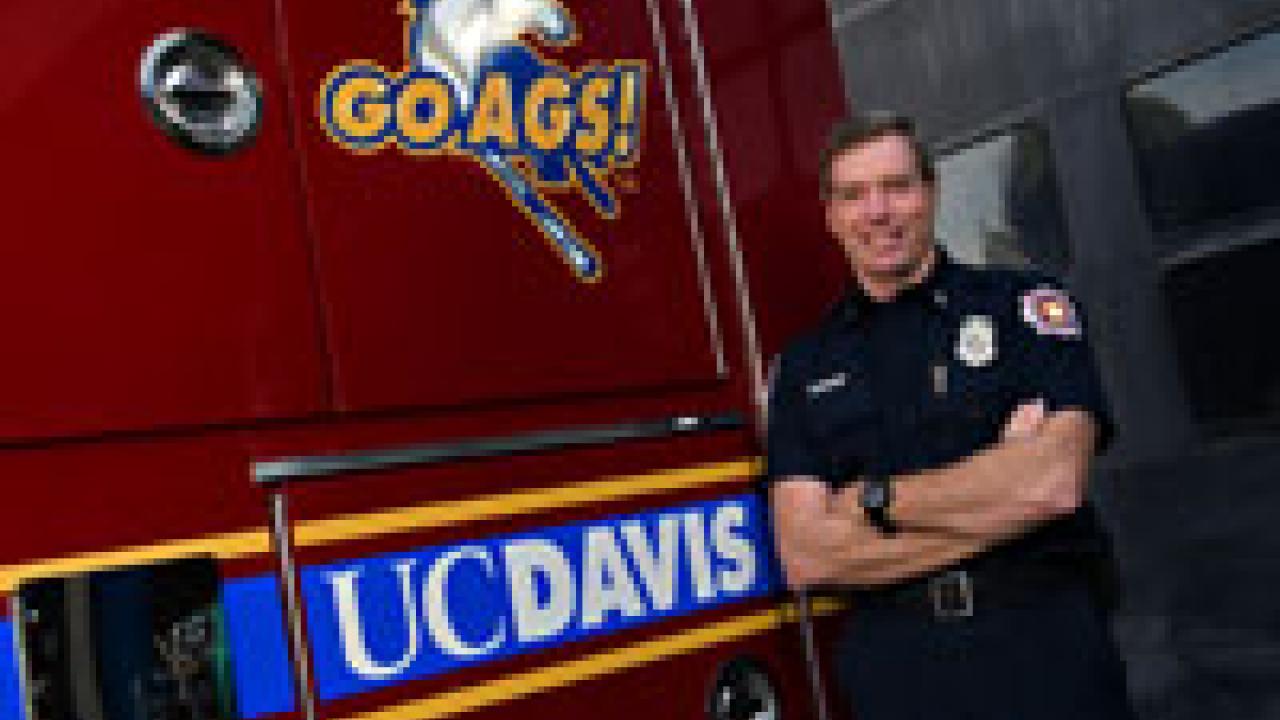UC Davis Fire Capt. Kim Jester was expecting a long but otherwise uneventful ride aboard one of five Yolo County fire engines heading to the raging Southern California wild land fires in October. When the convoy reached San Bernardino, a quickly moving grass fire alongside Interstate 215 erupted outside their windows.
For the next few hours, they poured all their resources and energy into stopping the wind-swept flames that were threatening this major transportation route in the Inland Empire region of Southern California — the eastern portion of the Greater Los Angeles area.
When they finally arrived at their destination, Lake Arrowhead, they were exhausted. Jester was traveling with a Yolo County contingent consisting of Davis, Woodland, Willow Oak, West Sacramento and Clarksburg fire personnel. He was eight hours behind a UC Davis fire crew that had left the campus the night before for an assignment in the Los Angeles area.
A 24-year veteran, Jeste was acting as a strike team leader trainee — a position he had held in other wildland fires. He, along with the Davis Fire Division Chief, Aramondo Jaramillo, would ultimately decide which houses to save in the brutal fire at Lake Arrowhead.
For this crew of 18 firefighters, the day shift began at 4:30 a.m. with breakfast, followed by a briefing. Then it was off to their primary mission of protecting homes. Because of raging winds, the fire that drove through parts of Lake Arrowhead went through this community with amazing speed.
"It would be foolish to think that you can outrun a fire fanned by the famous Santa Ana winds," said Jester. "With sustained winds blowing at 50 mph and gusts up to 62 mph, the pine trees were catching fire and jumping from tree-to-tree. Our job was to put out the fires that were caused when embers from the trees fell down and ignited anything combustible on the ground."
For this crew of 18, the day seemed like it would never end. They worked non-stop for 36 hours. Jester's job was to go down the streets and mark which houses they would attempt to save.
"I would look at a number of things to determine which homes our fire crews would have a chance of saving. Among some of the things I considered was the roofing material and safety zones. If the homes had wood shingles, no defensible space around it or no escape routes for our fire crews, we abandoned hope of saving it," he said.
One of the biggest worries for firefighters is getting trapped by these fast- moving fires. If a home was located in an area where it did not give fire crews enough turning space or safe zones, the home was not protected.
Jester said homes that were constructed with large raised decks became more vulnerable because they became heat traps. In these homes, the fires would tend to spread rapidly.
For their six days of aggressive work, Jester's Yolo County crew saved as many as 50 homes.
"Our job was to knock down these spot fires that came from blowing embers as quickly as possible because it wouldn't take long for them to ignite something combustible around the homes," Jester said.
Perhaps the best part of his experience was the sincere thanks extended to the crew for the work they did from the homeowners in the area, and the food that was provided.
"At the staging areas, large trucks would come in and set up a full kitchen and serve us superb meals. Initially we were eating 5,000 calories a day to keep us sustained," said Jester. "All the food choices were monitored by a registered dietician, so being a vegetarian, I appreciated the menu selections of fruits and vegetables," said the 51-year old veteran.
How did you become a firefighter?
I was a volunteer firefighter in Paradise after taking courses in fire science from Butte College. In 1983 I applied for a permanent firefighter position at UC Davis. The rest is history.
If you were not a firefighter what would you be doing?
I would be a forest ranger. How can you beat working outside and protecting the natural environment?
What is something about you that people do not know?
I raced motorcycles professionally for a couple of years back in the 1980s. I still own a Suzuki 1000 sport bike that flies as fast as the Santa Ana winds.
Media Resources
Clifton B. Parker, Dateline, (530) 752-1932, cparker@ucdavis.edu
